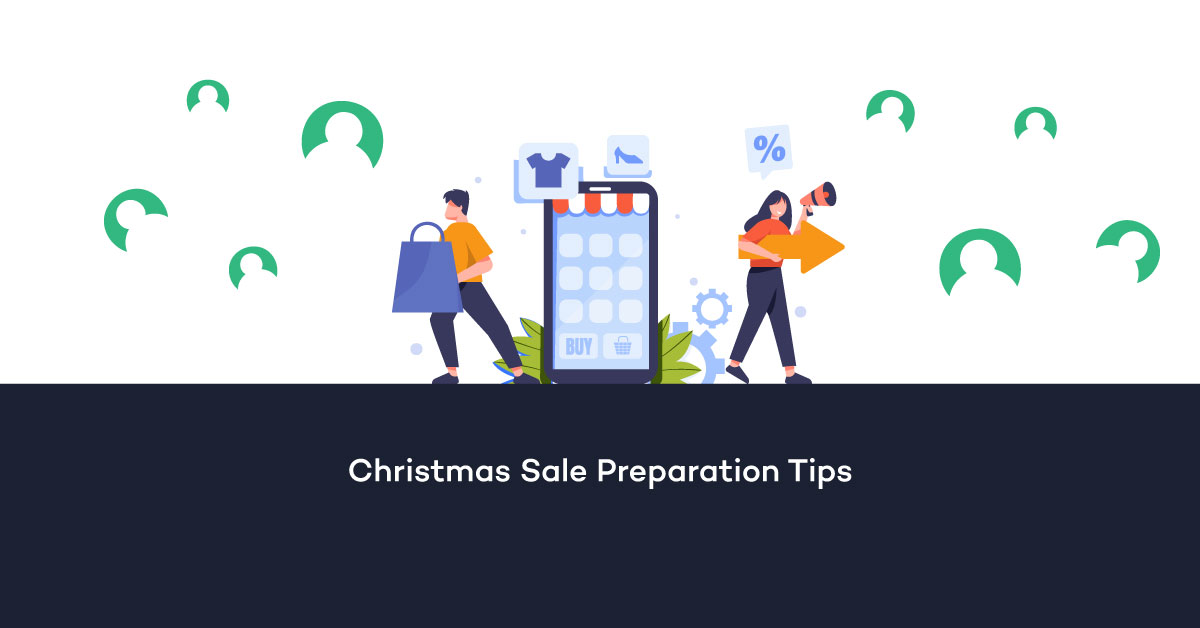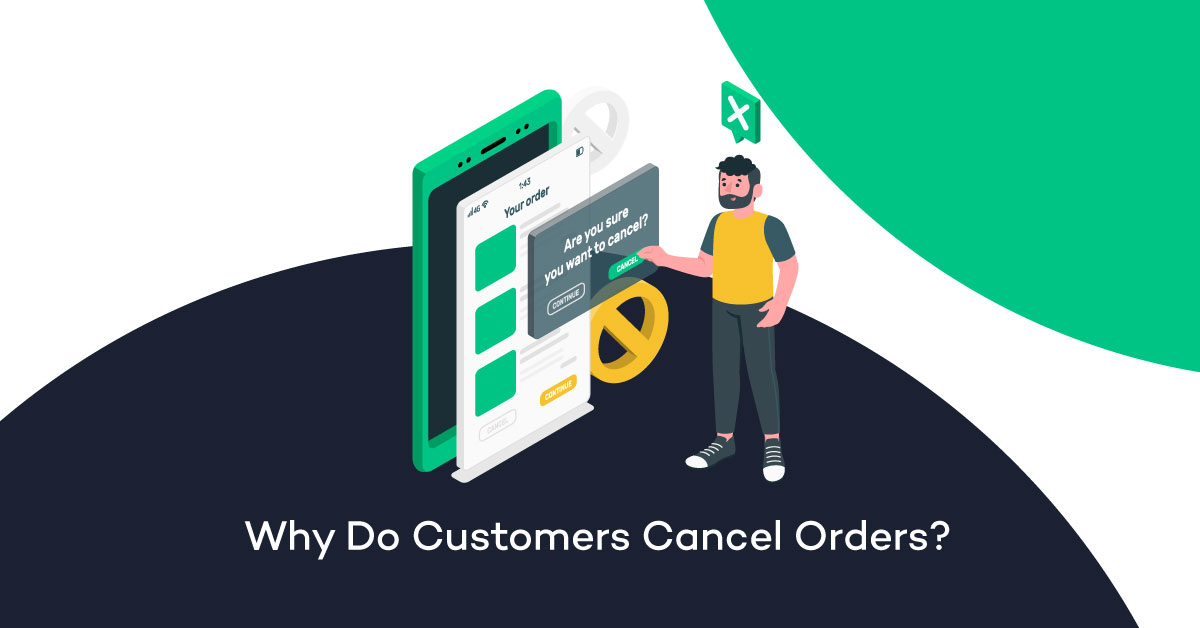One of the concerns of most authors, regardless of whether they are writing a short...
One of the concerns of most authors, regardless of whether they are writing a short story,� a novel, a non-fiction book, or any other form of literary work, includes publishing. The lack of cost-effective publishing options frequently hinders reaching a wider readership and building a loyal following.
Nonetheless, due to technological advancements and the growing trend of self-publishing, authors and writers have found ways to overcome the limitations posed by the lack of resources required for printing and distributing books.�
In particular, the emergence of self-publishing platforms like Amazon KDP has provided a convenient self-publishing solution, allowing authors to market their books to diverse audiences without the involvement of a traditional publishing company.�
What is Amazon KDP?�

An Overview of Self-Publishing
Before we delve into the intricacies of Amazon KDP, it is crucial to understand self-publishing better. We will explore the fundamental concepts and vital insights that underpin the self-publishing industry.�
What is Self-publishing?
The term self-publishing can be applied to various media. In the context of literary work, self-publishing pertains to the act of publishing a book or manuscript without the service of a traditional publishing house or company.
When an author chooses to self-publish a book, the author takes upon himself the whole publishing process, including but not limited to editing, designing the book cover, book formatting, and marketing.�
What makes self-publishing advantageous for authors is that they can have complete creative control over their work and higher royalty rates as compared to traditional publishing. With traditional publishing, authors will have to hurdle with competitions and deal with the time-consuming process.�
In traditional publishing, the process does not allow for an immediate publication of your completed manuscript or paperback books by publishers. Instead, you typically need to secure a literary agent first, and then you must seek out a publishing company willing to acquire the rights to your book.
A Brief History of Self-Publishing
In general, self-publishing�s history is highly connected with the evolution of publishing access, technology, and other relevant resources in the publishing world. Before the introduction of print-on-demand services, authors depended on traditional publishing houses whose history can be traced back to the early 14th century when Johannes Gutenberg invented the first printing press.
Authors have had to deal with traditional publishing companies for centuries and abide by their rules, including giving up a significant percentage of their royalties. It was only after the introduction of Desktop publishing in 1979 that authors were allowed to publish their work on their own terms.�
The 1980s and 90s introduced advancements in digital technology that allowed authors to gain more freedom in terms of self-publishing. Print-on-demand services offered by the likes of AuthorHouse and iUniverse made it easier for authors to have their books published.�
The early 2000s further revolutionized self-publishing, especially with the emergence of Amazon and its Kindle Direct Publishing (KDP) platform.�
Three Important Self-Publishing Resources
Authors intending to proceed with self-publishing must be familiar with some tools and resources that can help them publish their work. These resources are mainly classified into three categories: Author Services, Self-Publishing Education, and Self-Publishing Platforms.
Author Services: This self-publishing solution offers authors and writers the assistance they need for various tasks that some authors might not possess the skills or knowledge for. These tasks encompass areas such as editing, cover design, formatting, eBook conversion, marketing, and more.
Self-Publishing Education: Authors who wish to master self-publishing can benefit from self-publishing education. This resource consists of various educational materials, courses, or programs designed to guide self-publishers in completing their tasks. An excellent example of this is the Self Publishing School, an online education company offering multiple programs teaching authors how to publish and market their books.�
Self-Publishing Platform: Self-publishing platforms are the go-to solution for writers who wish to take control of their book�s publishing process. Self-publishing platforms like Amazon KDP provide authors with the tools and resources to publish their work independently.
What is Amazon KDP?�

Kindle Direct Publishing (KDP) is Amazon�s self-publishing platform that allows authors and writers to publish their work. The Kindle Direct Publishing Platform was launched in November 2007 with the purpose of helping writers pursue their passion while still earning higher royalties and retaining the rights to their work.
Amazon Kindle Direct Publishing has made self-publishing easier for independent authors and publishers to get a paperback book or eBook published. Amazon encourages authors to self-publish their paperbacks, hardcovers, and Kindle eBook through KDP at no initial cost. You will only incur charges until a book is sold.
Amazon allows publishing of both eBooks and print books of different types, including the following:
Novels Poetry Comics Journals Textbooks Cookbooks Book Series Children�s BooksBenefits of Using Amazon KDP
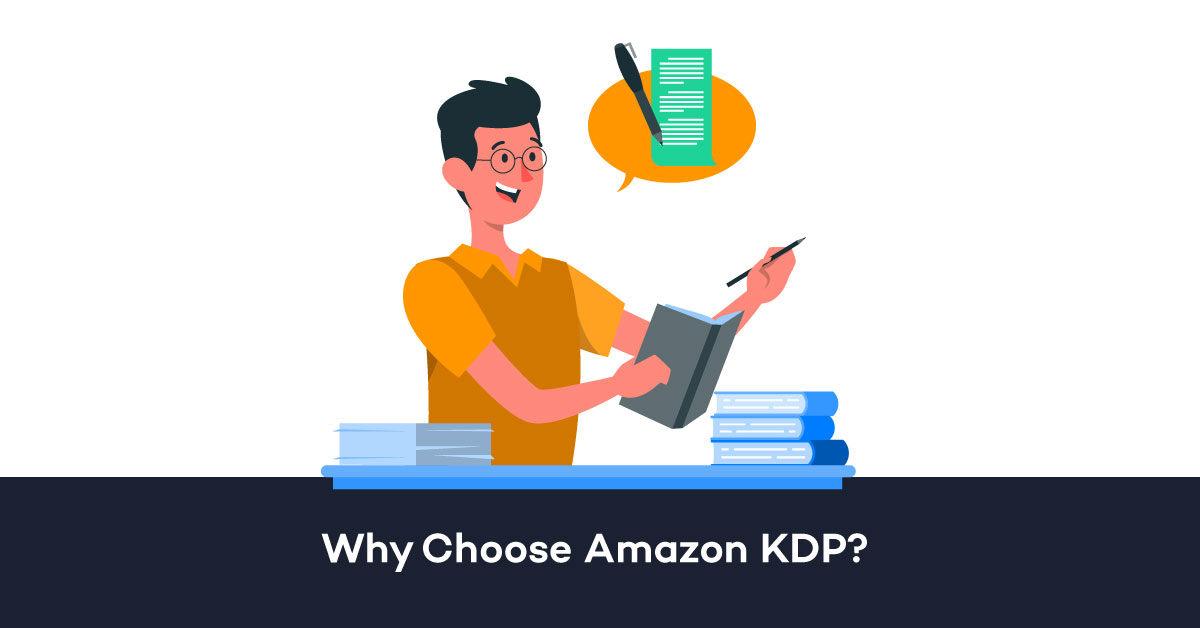
To understand why Amazon KDP is a favored choice among authors and writers who wish to self-publish their content, the following are some advantages of utilizing Amazon KDP.
Wide Distribution Channels: Since Amazon operates globally, authors will not be limited to specific regions. Amazon KDP offers wide distribution across the United States and other countries, including but not limited to the United Kingdom, Netherlands, Spain, Brazil, Mexico, India, Australia, and New Zealand.
Flexibility: With Amazon KDP, authors can choose whether to publish their work in an eBook format, printed books, or both. When choosing to publish books in paperback or hardcover, Amazon will handle the printing and shipping of the books to customers. You can also take advantage of Amazon Kindle Store and Kindle Unlimited for better reach.
Higher Royalty Rates: Self-publishing with Amazon KDP financially benefits authors because of higher royalties. With eBooks, authors can have as much as 70% royalty. On the other hand, authors can have as much as a 60% royalty rate on paperbacks sold if they choose the Amazon distribution channels, while only 40% for Expanded Distribution channels.�
Extensive Self-Publishing Capabilities: With a Kindle Direct Publishing account, you can publish a vast number of books. While Amazon has officially placed no limits on the number of books you can release through KDP, there is a cap of 500 books in the draft stage. Consequently, authors are required to await the review of currently uploaded book files before introducing additional titles.
Amazon Brand Presence: When your books are showcased on Amazon, they inevitably become linked with the esteemed Amazon brand. Given Amazon�s well-established reputation in the eCommerce industry, your book will likely receive similar recognition and acceptance among online shoppers. Moreover, Amazon also has its Kindle Store
Quicker Turnaround Time: One of the highly desired advantages of Amazon KDP is its turnaround speed. In the traditional publishing industry, your book can take anywhere from nine months to two years to hit the market once it enters production. However, with Amazon KDP, authors and writers can anticipate their book or related book updates to go live on Amazon within 3 to 10 business days.
Convenient and Cheaper Inventory: In the past, authors and writers were often required to buy their printed books in large quantities upfront. Amazon�s print-on-demand eliminates the need for bulk purchases because books are printed as they are ordered.
Overview on Self Publishing: How to Self-Publish a Book and Amazon KDP Guide
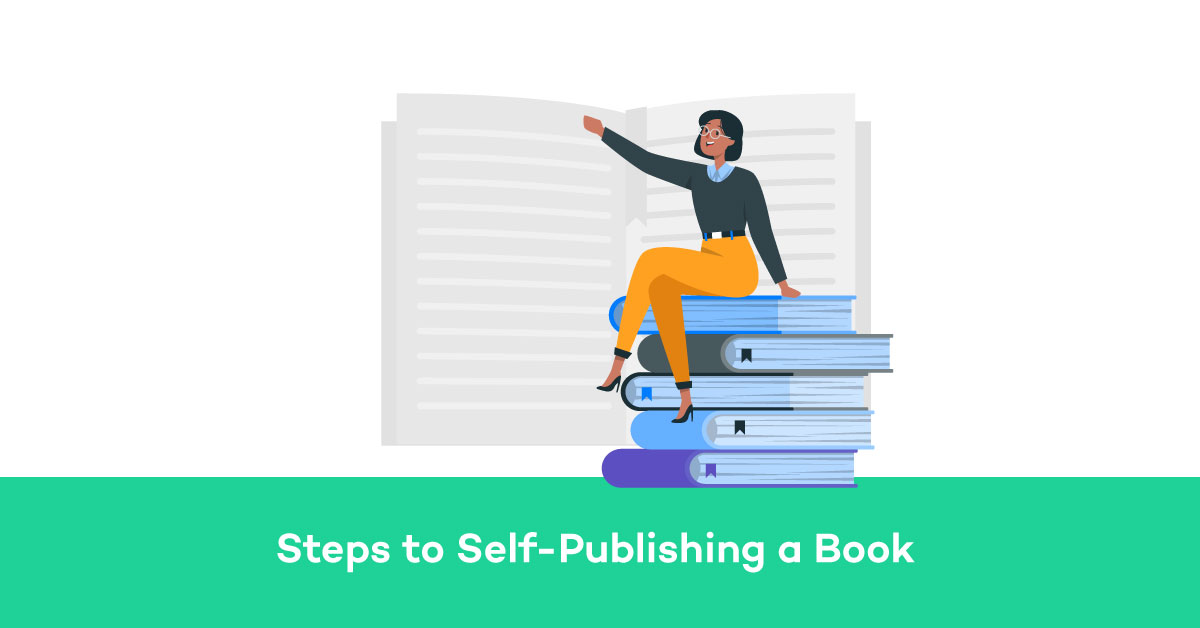
As previously highlighted, many authors and writers are opting for self-publishing instead of the conventional publishing route. If you are one of those authors who favor self-publishing, here is an overview of the steps you should take, along with potential costs associated for a particular process:
STEP 1 � Self-Edit Your Manuscript
After you finish writing your book, you must self-edit it. Self-editing the rough draft is vital, for it helps you view your work from a reader�s perspective while enabling you to correct simple errors.�
From a practical standpoint, self-editing is free. It can be performed multiple times by the author. Self-editing allows authors not just to spot loopholes in their work but also to hone their writing and editing skills for future books.�
STEP 2 � Look for Beta Readers
After self-editing, you should send your manuscript to beta readers. Beta readers can be likened to product testers, who will read your book and give feedback afterward.�
It should be noted that these beta readers are not professional editors nor expert critics.�
Beta readers can be your friend, colleague, or even a stranger who can point out simple errors or plot holes in your book. They can help you identify inconsistencies to improve your work further.
Once you have received feedback from beta readers, you can proceed with another editing session of your manuscript.�
STEP 3 � Professional Editing
Once the necessary enhancements through self-editing have been implemented in your project and any flaws have been corrected, it is time to submit your book to a professional editor for a more expert evaluation. Professional editors can provide significant support and can likewise introduce drastic improvements to your work.�
Typically, most self-publishers rely on professional editors to perform critical tasks such as proofreading, editing, and enhancing their manuscripts. It is estimated that for copyediting, the price ranges from $1,000 to $3,000, while developmental editing can range from $5,000 to $10,000 per book.
STEP 4 � Indexing
Indexing is necessary if you are working on a non-fiction book, such as a reference or academic book. Having an index in your book allows readers to navigate your book easily, which is why self-publishers are highly encouraged to let expert indexers perform such a task.�
The best place to start your search for an indexer is the American Society for Indexing. The cost for book indexing varies depending on the indexable pages, but on average, indexing will cost you around $500 to $1,200.
STEP 5 � Prepare Your Book Cover
Authors, writers, and independent publishers are aware that book covers create the first impression among potential readers. Whether you are planning to self-publish eBooks or printed books, hiring a book cover designer is essential.�
Book cover costs vary depending on the level of customization and quality you want. In most cases, hiring a book designer to make you a book cover can cost between $150 to $500 or more on average.�
STEP 6 � Secure an International Standard Book Number (ISBN)
Self-publishers have two options when it comes to securing ISBNs. You can either purchase one from online sources such as Bowker or obtain an ISBN for free from your publishing platform. Currently, a single ISBN is priced at $125.�
If you plan to publish only eBooks, ISBN is not needed. However, if you want to publish printed copies of your manuscript, then ISBN is necessary. Amazon KDP will provide you with a free ISBN during publishing.��
STEP 7 � Proofreading
Authors and writers must hire a professional proofreader to check everything down to the last letter and punctuation mark. The average proofreading rate per word is $0.013 to $0.016. This step should not be taken lightly, for any unchecked mistakes in writing or layout can harm the reading experience.�
STEP 8 � Marketing Your Book
You should consider marketing your book long before its release in order to increase potential book sales. You can organize a pre-order campaign to drive sales and attract attention to your book.�
With a vast array of marketing software and services online, the average cost to market your book can range from as low as $50 to upwards of $8,000. You can also leverage social media platforms to improve marketing and promotion campaigns.�
STEP 9 � Publishing
When it comes to publishing your book, you have various options available online. However, the most popular platform for self-publishing today is the Kindle Direct Publishing by Amazon. Amazon currently has over 85% of the book market share, making it an ideal platform for authors and writers who wish to self-publish their work for free.�
How Does Amazon KDP Work? | How to Publish a Book on Amazon KDP�
Amazon KDP is a platform that empowers writers and authors to self-publish their works without any upfront cost. In order to begin the task of self-publishing, the first crucial step is to create your Amazon KDP account. Assuming you have already followed the steps discussed in the previous section, the subsequent stage involves uploading your book files to the KDP platform.
Once your account setup is complete, you can initiate the publishing process to make your book accessible to readers. Once published, readers can readily download eBooks or purchase printed books on Amazon. Eventually, when someone acquires your book, Amazon will compensate you with a royalty.
For a step-by-step guide on the process of uploading and publishing your book using Amazon KDP, please refer to the video presentation provided below:
Amazon KDP FAQs | Frequently Asked Questions About Self-Publishing
What are the types of content that are not allowed on KDP?
Amazon KDP allows numerous content on its platform except for the following:
Magazines Periodicals Calendars Spiral bound booksCan I use Amazon KDP to publish content that is currently published elsewhere?
Yes, authors can use KDP for content previously published elsewhere, provided they own the rights to their book.�
Do you really make money with KDP?
Making money through Amazon KDP is possible since it provides more generous royalties compared to most self-publishing platforms. Authors and writers have the potential to earn as much as 70% in royalties for each ebook sold.
How is Amazon KDP printing cost calculated?
To calculate the printing cost for both hardcover and paperback, Amazon observes this formula:
Fixed cost + (page count * per page cost) = printing cost
For reference, here below is an overview of the black ink paperback and hardcover fixed cost.
Black Ink Paperback:
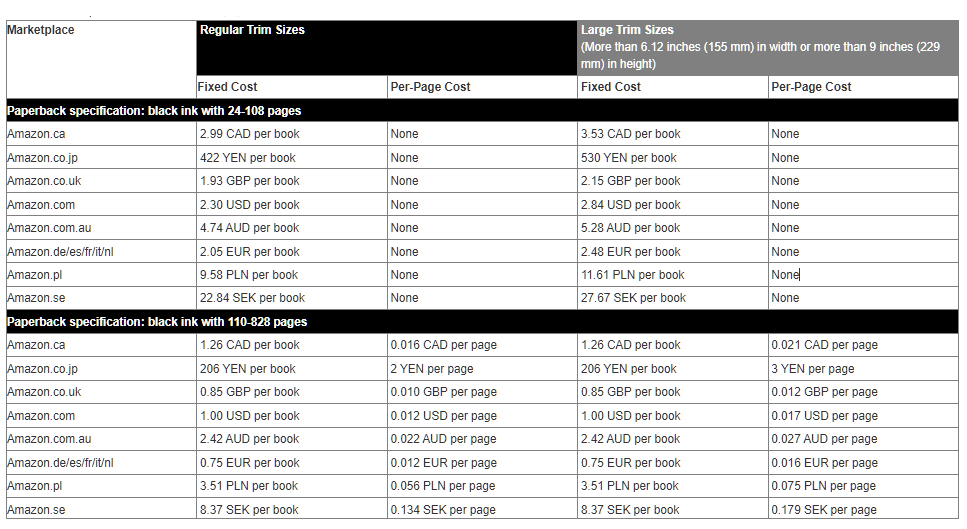
Source: Amazon
Black Ink Hardcover :

Source: Amazon
What are the contents that Amazon KDP prohibits?
Amazon KDP prohibits books or materials that are illegal or infringe proprietary rights. Amazon does not allow offensive content, including those containing �hate speech, promotes the abuse or sexual exploitation of children, contains pornography, glorifies rape or pedophilia, advocates terrorism,� and other materials deemed inappropriate by Amazon.
Publishing and Beyond With Amazon KDP
Seasoned authors, budding writers, and self-publishing enthusiasts can significantly enhance their chances of success by harnessing the power of Amazon KDP. This platform serves not merely as a publishing avenue; it offers a comprehensive ecosystem where authors and writers can publish and promote their works effectively.
Furthermore, self-publishers can tap into Amazon�s well-established brand and efficient fulfillment system to seamlessly connect with a broader audience and ensure swift delivery of their orders, further bolstering their publishing endeavors.






